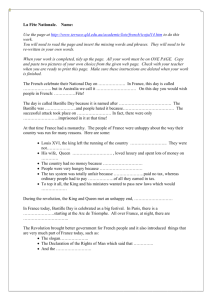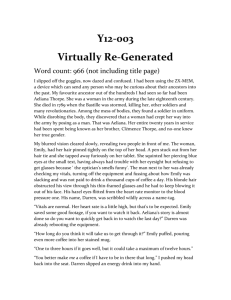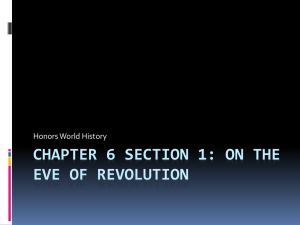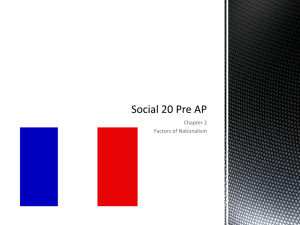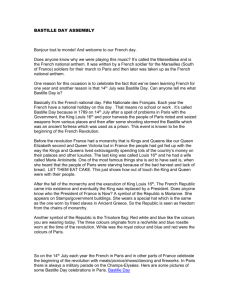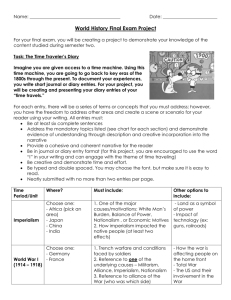Storming of the Bastille
advertisement
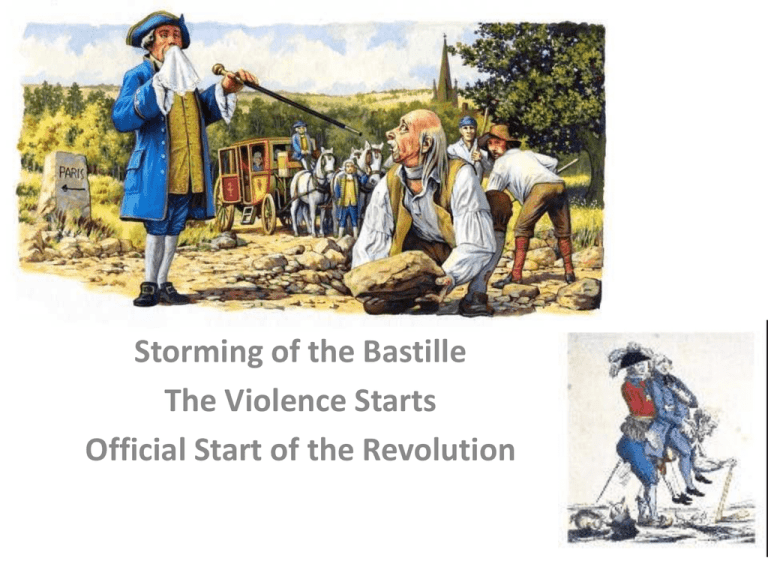
Storming of the Bastille Storming of the Bastille The Violence Starts Official Start of the Revolution Bastille Significance • It was originally built in the 14th century to guard one of main entrances to Paris, but by the 18th century the Bastille served only as a prison - mainly for political, aristocratic prisoners who could not be thrust into the crowded gaols (jails) with common criminals and occasionally as a store for arms. • The fortress also accommodated printers, booksellers and authors who produced works that the authorities considered seditious. • Voltaire was imprisoned there twice: first in 1717 when he was suspected of writing verses accusing the Régent of incest, and then again in 1726. • Throughout the 18th century there were never more than 40 inmates, most of them serving short sentences. • On July 14, 1789, when the Bastille was stormed, there were only half a dozen prisoners, two of whom were insane. Causes of the Storming • During the summer of 1789, food riots broke out in Paris due to a bread shortage. • The working class was hungry and angry over their decreasing wages and increasing prices. • In early July, King Louis XVI stationed 17 regiments of Swiss Guards and German mercenaries in Paris and around Versailles supposedly to restore order. • People whispered that the King was going to use the soldiers against the people and to force the National Assembly to disperse. • Louis then fired the liberal finance minister, Jacques Necker, who had wanted to tax everyone and was a hero to the Third Estate. • Louis turned to new advisors who were totally against change. • Angry crowds attacked the custom posts where the high taxes on flour were collected. • They looted and burned shops. • They rushed to arm themselves. • Order was restored on July 13, but then broke out again on July 14. • The people in Paris were convinced the troops would attack them. • And the Bastille was a symbol of the unfair arrest and jailing of innocents. • At the Bastille, there were hundred barrels of gunpowder. Events Prior to the Storming • The time was half past three, on the famous date of July 14, 1789. • A huge, bloodthirsty mob marched to the Bastille, searching for gun powder and prisoners that had been taken by the unpopular and detested King Louis XVI. • Even elements of the newly formed National Guard were present at the assault. • The flying rumors of attacks from the government and the biting truth of starvation were just too much for the angry crowds. • The Bastille had been prepared for over a week, anticipating about a hundred angry subjects and along the thick rock walls of the gargantuan fortress and between the towers were twelve more guns that were capable of launching 24ounce case shots at any who dared to attack. • However, the enraged Paris Commune was too defiant and too livid to submit to the starvation and seeming injustice of their government. • But nothing could have prepared the defenders for what they met that now famous day. • • • • • • • • • The Bastille was governed by a man named Marquis de Launay. On July 7th, thirty-two Swiss soldiers led by Lieutenant Deflue, came to aid de Launay, helping him to prepare for a small mob. Rumors were flying everywhere. The Marquis was expecting a mob attack, but certainly not a siege! The entire workforce of the Bastille had stealthily and furiously been repairing the Bastille and reinforcing it, all to prepare for a minor attack from a hundred or so angry citizens. At three o'clock that afternoon, however, a huge group of French guards and angry citizens tried to break into the fortress. There were over three hundred people ready to give their lives to put an end to their overtaxing and overbearing government. However the Bastille was threatened by more than the numerous crowds: three hundred guards had left their posts earlier that day, out of fear and from the rumors. The besiegers easily broke into the arsenal and into the first courtyard, cut the drawbridge down, and then quickly got through the wooden door behind it. They boldly demanded that the bridges be lowered, but they were refused. The Marquis de Launay said he would surrender if his troops were allowed to leave peacefully, but he was simply rebuked. They wanted de Launay on a noose or with his head in a basket. The Actual Attack on the Bastille • A hastily formed militia and a mob of about 900 people went to the Invalides, a military hospital, to get weapons. • Then they turned their attention to the Bastille. There was gun powder stored at the Bastille. • In the streets, they chanted “A la Bastille.” • They demanded that the Governor Marquis de Launay surrender the prison and the 250 barrels of gunpowder stored in the cellar. • DeLaunay refused to surrender. Tension grew. • Then a gunshot was fired, but no one knew by who. • A man fell dead into the prison moat. • The mob stormed the courtyard. Taking The Bastille Primary Sources • “First, the people tried to enter this fortress by the Rue St.-Antoine, this fortress, which no one has ever penetrated against the wishes of this frightful despotism and where the monster still resided. The treacherous governor had put out a flag of peace. So a confident advance was made; a detachment of French Guards, with perhaps five to six thousand armed bourgeois, penetrated the Bastille's outer courtyards, but as soon as some six hundred persons had passed over the first drawbridge, the bridge was raised and artillery fire mowed down several French Guards and some soldiers; the cannon fired on the town, and the people took fright; a large number of individuals were killed or wounded; but then they rallied and took shelter from the fire; ... meanwhile, they tried to locate some cannon; they attacked from the water's edge through the gardens of the arsenal, and from there made an orderly siege; they advanced from various directions, beneath a ceaseless round of fire. It was a terrible scene....” Primary Sources • “The fighting grew steadily more intense; the citizens had become hardened to the fire, from all directions they clambered onto the roofs or broke into the rooms; as soon as an enemy appeared among the turrets on the tower, he was fixed in the sights of a hundred guns and mown down in an instant; meanwhile cannon fire was hurriedly directed against the second drawbridge, which it pierced, breaking the chains; in vain did the cannon on the tower reply, for most people were sheltered from it; the fury was at its height; people bravely faced death and every danger; women, in their eagerness, helped us to the utmost; even the children, after the discharge of fire from the fortress, ran here and there picking up the bullets and shot; [and so the Bastille fell and the governor, De Launey, was captured].... Serene and blessed liberty, for the first time, has at last been introduced into this abode of horrors, this frightful refuge of monstrous despotism and its crimes.” Attack Continued • Then the mob was reinforced by a group of French soldiers who had abandoned the King’s regiments. • They brought with them cannons. • The cannons were aimed at the drawbridge and were about to be fired, when a few of the soldiers guarding the Bastille dropped the drawbridge. • The mob surged into the Bastille and attacked anyone in their path. • They seized the gunpowder. • Later that evening, they remembered the prisoners locked in the Bastille and freed them. Events of the Storming • • • • • • The vicious crowds shouted for him to lower the bridges. De Launay sent a note to a mob leader named Hulin, claiming that he had 20,000 pounds of gunpowder and if the besiegers did not accept his offer, he would annihilate the entire fortress, the garrison, and everyone in it! Yet, they still refused. The bridges were finally lowered on de Launay's command, and he and his soldiers were captured by the crowds and dragged through the filthy streets of Paris. The mob paraded through the streets, showing off their captives, and crudely cutting off many heads. The National Guard tried to stop the crowds from looting, but it was useless. They continued marching on, maKing their way to the Hotel de Ville. Upon learning that the Bastille had been taken, King Louis XVI, who was residing at Versailles, was reported to have asked an informer: "Is this a revolt?" and La Rochefoucauld-Liancourt said, "No, Sire, it is a revolution." Little did Louis know that the mob's next plan was to march to Versailles, and take him away with them as well. Outcomes of the Storming • The seven prisoners were freed. They were two madmen, four forgers, and one aristocrat jailed for debauchery. • 98 men were killed. • 100 were wounded. • Three officers from the Bastille were marched to City Hall and hung from lampposts. • DeLaunay had his throat cut and his head paraded on a pitchfork. Primary Source • “Meanwhile, they get ready to march; they leave amidst an enormous crowd; the applause, the outbursts of joy, the insults, the oaths hurled at the treacherous prisoners of war; everything is confused; cries of vengeance and of pleasure issue from every heart; the conquerors, glorious and covered in honor, carry their arms and the spoils of the conquered, the flags of victory, the militia mingling with the soldiers of the fatherland, the victory laurels offered them from every side, all this created a frightening and splendid spectacle. “ Primary Source • “On arriving at the square, the people, anxious to avenge themselves, allowed neither De Launey nor the other officers to reach the place of trial; they seized them from the hands of their conquerors, and trampled them underfoot one after the other. De Launey was struck by a thousand blows, his head was cut off and hoisted on the end of a pike with blood streaming down all sides.... This glorious day must amaze our enemies, and finally usher in for us the triumph of justice and liberty. In the evening, there were celebrations.” • Here is a picture of the killing of De Launay. He had been promised safety if he surrendered. Instead, he had his head chopped off and put on a pitchfork to be paraded around Paris. Primary Sources • “The decapitation of de Launai worked powerfully thro' the night on the whole Aristocratical party, insomuch that in the morning those of the greatest influence on the Count d'Artois represented to him the absolute necessity that the king should give up every thing to the states. This according well enough with the dispositions of the king, he went about 11 oclock, accompanied only by his brothers, to the States general, and there read to them a speech, in which he asked their interposition to re-establish order. . . Tho this be couched in terms of some caution, yet the manner in which it was delivered made it evident that it was meant as a surrender at discretion.The storming of the Bastille . . . “ • Thomas Jefferson, American minister in France Punishment Of Foulon Effects of the Storming • The King recalled Necker. • The King accepted the National Assembly and the red, white, and blue colors of the revolution. • Lafayette was named the commander of the militia, the National Guard. • Bailly became the first president of the National Assembly and mayor of the new city government. • The Bastille had fallen to an unarmed crowd of civilians. • It became the symbol for rebelling against tyranny. • This is considered to be the official start of the French Revolution. • July 14, 1789 is now considered the French Independence Day. Lafeyette made head of the National Guard Primary Source • “The demolition of the Bastille was now ordered, and begun. A body of the Swiss guards, of the regiment of Ventimille, and the city horse guards join the people. The alarm at Versailles increases instead of abating. They believed that the Aristocrats of Paris were under pillage and carnage, that 150,000 men were in arms coming to Versailles to massacre the Royal family, the court, the ministers and all connected with them, their practices and principles. The Aristocrats of the Nobles and Clergy in the States general vied with each other in declaring how sincerely they were converted to the justice of voting by persons, and how determined to go with the nation all it's lengths. The foreign troops were ordered off instantly.” • Thomas Jefferson, American minister in France Effects of the Storming of the Bastille • On the next slide, we see a political cartoon, implying that after the Storming of the Bastille, the First and Second Estates will have to dance to the tune of the Third Estates, as the common people became more important in the Revolution. • The piper of the Third Estate is wearing a revolutionary cockade in his hat, with the colors of the new French Flag in it, the white the color of the Bourbon monarchy, and the red the color of the revolutionaries. The Crushed Aristocracy "General Federation of the French" This image provides a visual overview of the Festival of Federation of 14 July 1790. Commemorating the fall of the Bastille one year earlier, this massive military parade of troops from all regions of the kingdom converged on a triple–tiered triumphal arch where all the soldiers swore an oath to serve the king and the National Assembly. The pageant drew nearly a million spectators and represented the apex of the social, geographical and political unity that reformers and early revolutionaries hoped would solve France’s problems. This festival was a powerful counterpoint to those who believed that the social question ultimately would undermine the Revolution. Source: mfr 83.289 Nouvelle Place de la Bastille. [New Square of the Bastille] Caption: Ami le temps passé n’est plus, rendons à César ce qui appartient à César, et à la Nation ce qui est à la Nation. (Louis XVI, Restaurateur de la Liberté Française) [View English translation] Source: Library of Congress PP PC5 1789.12 Medium: Etching, hand colored Dimensions: 21 x 18.5 cm 4. • Celebration of Bastille Day on July 14, 1790 The remains! The successful attack on the Bastille became a very important event for French people, since it showed that they were able to challenge the king's authority. Today, this is all that remains of the Bastille!
